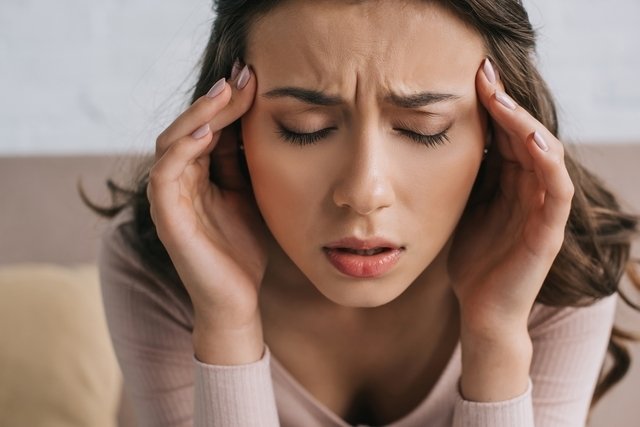Pressure in the head can be caused by everyday situations, such as stress or poor posture, or be due to sinusitis, labyrinthitis, meningitis, dental problems or migraines.
The sensation of pressure in the head may be accompanied by other symptoms, such as dizziness, headache, nausea, a feeling of tightness in the eyes and difficulty concentrating, for example, which may be indicative of a disease that must be properly identified by the doctor. .
Doing relaxing activities such as meditation, exercise and acupuncture, for example, in addition to using analgesic medications recommended by a neurologist or general practitioner are measures that help relieve pressure in the head. However, if the pain is constant and lasts more than 48 hours at a time, it is recommended to consult a doctor to carry out an assessment and begin the most appropriate treatment.
Main causes
The main causes of pressure in the head are:
1. Migraine
Migraine is a type of headache, more common in women, which is caused by changes in the blood flow of the brain and the activity of cells in the nervous system, and may be hereditary, that is, people who have close family members with this condition they may also develop migraines.
Migraine symptoms are triggered by some situations such as stress, changes in climate, ingestion of caffeine-based foods and can vary from one person to another, but are generally pressure in the head, with an average duration of 3 hours and can last up to 72 hours. , nausea, vomiting, sensitivity to light and sound and difficulty concentrating. See other migraine symptoms.
What to do: If the sensation of pressure in the head, present in a migraine, is constant or worsens after 3 days, it is necessary to consult a neurologist to indicate the most appropriate treatment, which is generally based on the use of medications to relieve pain such as analgesics, muscle relaxants and triptans, known as sumatriptan and zolmitriptan.
2. Stress and anxiety
Emotional stress and anxiety can cause physical changes, such as the feeling of pressure in the head, and this happens because these feelings cause the body’s muscles to become more stretched and lead to an increase in the hormone cortisol.
In addition to pressure in the head, these feelings can cause discomfort, cold sweat, shortness of breath and increased heart rate, so it is important to take measures that contribute to reducing stress and anxiety, such as doing activities that involve meditation, such as yoga, and perform some type of aromatherapy. Learn some more steps to overcome anxiety.
What to do: If stress and anxiety do not improve with changing habits and relaxation activities, it is important to consult a psychiatrist, as these feelings often harm personal life, make relationships between people difficult and influence work, making it necessary to use medication. specific drugs, such as anxiolytics.
3. Sinusitis
Sinusitis occurs due to inflammation caused by bacteria, viruses or fungi, in the region of the sinuses, which are bone cavities that are located around the nose, cheekbones and around the eyes. This inflammation causes an accumulation of secretions to occur, causing an increase in pressure in these areas, which is why it is possible to feel the sensation of pressure in the head.
Other symptoms may appear in addition to pressure in the head, such as nasal obstruction, greenish or yellowish phlegm, cough, excessive tiredness, burning eyes and fever.
What to do: If these symptoms appear, the ideal is to seek out an ENT doctor to recommend the correct treatment, which consists of the use of anti-inflammatories and, in cases where sinusitis is caused by bacteria, the use of antibiotics may be recommended. To improve the symptoms of this disease, you must also drink plenty of water during the day and wash your nose with saline solution to drain accumulated secretions. See more about how to wash your nose to unclog your nose.
4. High blood pressure
Arterial hypertension, better known as high blood pressure, is a chronic disease that is characterized by maintaining very high blood pressure in the arteries and generally occurs when values exceed 140 x 90 mmHg, or 14 by 9. If the person measures the pressure and if values are high it does not necessarily mean that it is high blood pressure, so to be sure of the diagnosis it is necessary to continually check the pressure.
The symptoms of high blood pressure can be pressure in the head, pain in the back of the neck, nausea, blurred vision and malaise and the appearance of these signs are associated with the use of cigarettes, consumption of excessive alcoholic beverages, eating fatty foods and foods with a lot of salt, lack of physical exercise and obesity.
What to do: There is no cure for high blood pressure, but there are medications to control blood pressure and should be recommended by a general practitioner or cardiologist. In addition to medications, it is necessary to make a change in lifestyle habits, such as eating a balanced diet with low salt content.
5. Labyrinthitis
Labyrinthitis occurs when the labyrinthine nerve, located inside the ear, becomes inflamed because of a virus or bacteria, causing pressure in the head, tinnitus, nausea, dizziness, lack of balance and vertigo, which is the sensation that the surrounding objects are spinning.
This change can also arise due to an injury to the ear region and can be triggered by the consumption of certain foods or traveling by boat or plane. See more on how to identify labyrinthitis.
What to do: When these symptoms appear, it is important to consult an otolaryngologist who may request tests to confirm the diagnosis of labyrinthitis. After being sure that it is labyrinthitis, the doctor may recommend medications to reduce the inflammation of the labyrinth nerve and to alleviate the symptoms, which may be dramamin or meclin.
6. Dental problems
Some dental or dental problems can lead to pressure in the head, tinnitus and ear pain, for example, changes in the way you chew food, bruxism, tooth infiltration due to cavities. In some cases, these changes also cause swelling in the mouth and noises when moving the jaw, such as clicking. See more about how to identify tooth decay.
What to do: As soon as symptoms appear, it is necessary to seek care from a dentist to carry out exams, check the condition of the teeth and analyze chewing movements. Treatment for these dental problems depends on the causes, however, it may be necessary to undergo root canal treatment, for example.
7. Meningitis
Meningitis is an infection of the protective membranes surrounding the brain and spinal cord and is most often caused by a bacterial or viral infection. Infectious meningitis can be acquired through the spread of microorganisms through sneezing, coughing and sharing utensils such as cutlery and toothbrushes. Find out more about how you get meningitis.
Meningitis can also be caused by other diseases, such as lupus or cancer, severe blows to the head and even the excessive use of certain drugs. The main symptoms of meningitis can be pressure-like pain in the head, stiff neck, difficulty touching the chin to the chest, fever, red spots spread across the body and excessive drowsiness.
What to do: When meningitis is suspected, it is necessary to seek medical attention immediately so that tests can be carried out, such as MRI and cerebrospinal fluid assessment, with the aim of confirming the diagnosis and starting treatment earlier, which is normally carried out in a hospital through the administration of medication. directly into the vein.
8. Bad posture
Poor posture or inadequate posture, during work or study, leaves the body very contracted and can overload the joints and muscles of the spine, causing changes and leading to a feeling of pressure in the head and back pain. Lack of movement and staying in one place or sitting for long periods are harmful to the body and also cause these symptoms.
What to do: For symptoms to be alleviated, it is necessary to continue practicing physical exercises, such as swimming and walking, and it is possible to feel improvements in pressure in the head and pain in the spine through stretching activities.
When to go to the doctor
You should seek medical attention quickly if, in addition to the sensation of pressure in the head, symptoms such as:
- Asymmetrical face;
- Loss of consciousness;
- Numbness or tingling in the arms;
- Lack of sensitivity on one side of the body;
- Seizures.
These signs may indicate a stroke or increased intracranial pressure and these situations require urgent medical attention, so when they arise it is necessary to immediately call the SAMU ambulance on 192.

Sign up for our newsletter and stay up to date with exclusive news
that can transform your routine!
Warning: Undefined array key "title" in /home/storelat/public_html/wp-content/plugins/link-whisper-premium/templates/frontend/related-posts.php on line 12
Warning: Undefined array key "title_tag" in /home/storelat/public_html/wp-content/plugins/link-whisper-premium/templates/frontend/related-posts.php on line 13




